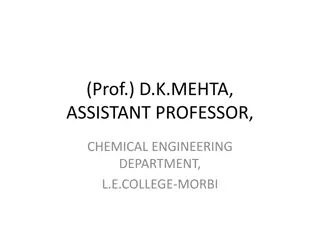Applications and Advantages of Gas Chromatography Mass Spectrometry (GC-MS)
Gas Chromatography Mass Spectrometry (GC-MS) is a powerful analytical technique that combines gas-liquid chromatography and mass spectrometry for substance identification. It offers superior performance with features like enhanced molecular ion, improved confidence in identification, wider sample range analysis, faster processing, and enhanced sensitivity. GC-MS finds applications in environmental monitoring for organic pollutants and biological detection of drugs and pesticides.
Download Presentation

Please find below an Image/Link to download the presentation.
The content on the website is provided AS IS for your information and personal use only. It may not be sold, licensed, or shared on other websites without obtaining consent from the author.If you encounter any issues during the download, it is possible that the publisher has removed the file from their server.
You are allowed to download the files provided on this website for personal or commercial use, subject to the condition that they are used lawfully. All files are the property of their respective owners.
The content on the website is provided AS IS for your information and personal use only. It may not be sold, licensed, or shared on other websites without obtaining consent from the author.
E N D
Presentation Transcript
GC-MS Pratima Katiyar
Introduction Gas Chromatography Mass Spectrometry (GC-MS) is a hyphenated analytical technique that combines the separation properties of gas-liquid chromatography with the detection feature of mass spectrometry to identify different substances within a test sample. GC is used to separate the volatile and thermally stable substitutes in a sample whereas GC-MS fragments the analyte to be identified on the basis of its mass. The further addition of mass spectrometer in it leads to GC- MS/MS. Superior performance is achieved by single and triple quadrupole modes
Advantages of GC-MS GC requires the analyte to have significant vapor pressure between 30 and 300 C. GC presents a insufficient proof of the nature of the detected compounds. The identification is based on retention time matching that may be inaccurate or misleading. GC-MS represents the mass of a given particle (Da) to the number (z) of electrostatic charges (e) that the particle carries. The term m/z is measured in DA/e
Contin.. The main features of enhanced molecular ion, improved confidence in sample identification, significantly increased range of thermally labile and low volatility samples amenable for analysis, much faster analysis, improved sensitivity particularly for compounds that are hard to analyze and the many other features and options provide compelling reasons to use the GC-MS in broad range of areas
Applications Environmental monitoring: GC-MS has become a highly recommended tool for monitoring and tracking organic pollutants in the environment. .The determination of chloro-phenols in water and soil, polycyclic aromatic hydrocarbons (PAH), unleaded gasoline, dioxins, dibenzofurans (Figure 2), organo-chlorine pesticides, herbicides, phenols, halogenated pesticides, sulphur in air is very convenient to be screened by this technique
Biological and pesticides detections GC-MS is exclusively used in bio-analysis of blood, urine for the presence of barbiturates, narcotics, alcohols, residual solvents, drugs like anesthetics, anticonvulsant, antihistamine, anti-epileptic drug, sedative hypnotics, narcotics and food items . This technique could be used for detecting adulterations, fatty acid profiling in microbes, presence of free steroids, blood pollutants, metabolites in serum, organo-chlorinated pesticides in river water, drinking water, soft drinks by head space, pesticides in sunflower oil etc
Food, beverage, flavor and fragrance analysis GC-MS is exclusively used for the analysis of esters, fatty acids, alcohols, aldehydes, terpenes etc. GC-MS is also used to detect and measure contaminants, spoilage and adulteration of food, oil, butter, ghee that could be harmful and should to be controlled and checked as regulated by governmental agencies. It is used in the analysis of piperine ,spearmint oil, lavender oil, essential oil, fragrance reference standards, perfumes, chiral compounds in essential oils, fragrances, menthol, allergens, olive oil, lemon oil, peppermint oil, yiang oil, straw berry syrup, butter triglycerides, residual pesticides in food and wine.
Forensic and criminal cases The analysis of fire debris using GC-MS can be established by American Society for Testing Materials (ASTM) standard for fire debris analysis. It is the key tool used in sports anti-doping laboratories to test athlete s urine samples for prohibited performance enhancing drugs like anabolic steroids. It is also commonly used in forensic toxicology to find poisons, steroids in biological specimens of suspects, victims, or the deceased.
Medicine and Pharmaceutical Applications GC-MS is widely used in pharmaceutical industries for analytical research and development, quality control, quality assurance, production, pilot plants departments for active pharmaceutical ingredients (API), bulk drugs and formulations. It is used for process and method development, identification of impurities in API. It is an integral part of research associated with medicinal chemistry.
References Sahil K, Prashant B, Akanksha M, Premjeet S, Devashish R (2011) GC-MS: Applications. International Journal Pharma & Biological Archives 2: 1544-1560. 2. Jenke DR (1996) Chromatographic Method Validation: A review of Current Practices and Procedures. I. General Concepts and Guidelines. J Liq Chrom & Rel Technol 19: 737-757. 3. Rowley AG (2001) Evaluating Uncertainty for Laboratories. A Practical Hand 4.Ashish chauhan, Manish kumar Goyal 2014, GC-MS Technique and its Analytical Applications in Science and Technology, Analytical & Bioanalytical Techniques.























